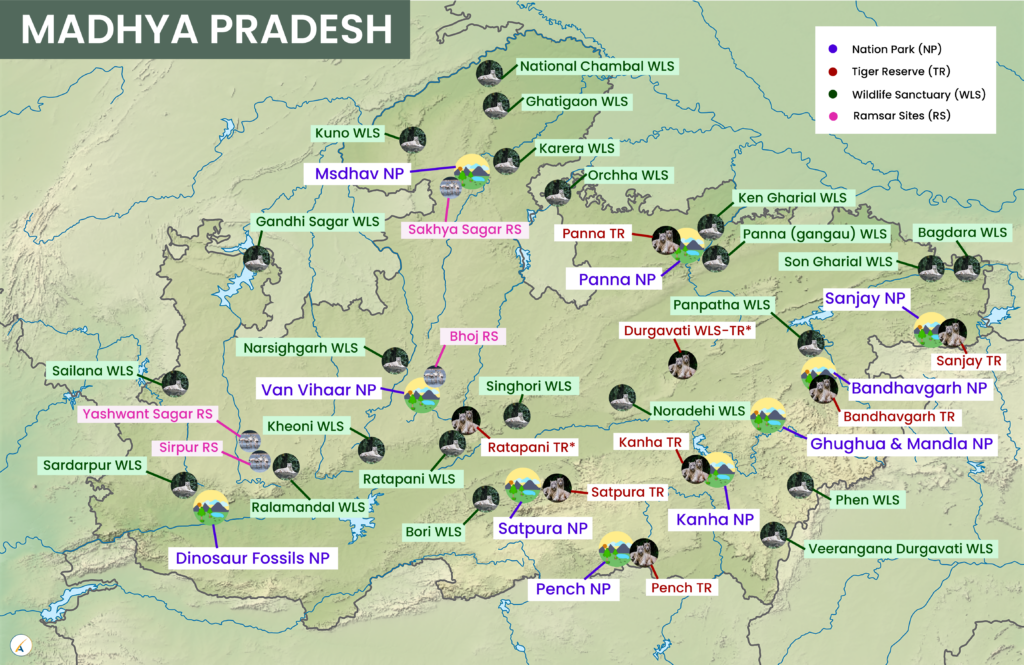Table of Contents
Context: The Madhya Pradesh government has finished preparing the Gandhi Sagar Wildlife Sanctuary as a new habitat for cheetahs, marking it as the second designated cheetah sanctuary in India after Kuno National Park.
Cheetah Reintroduction Project in India
- The Cheetah Reintroduction Project in India was officially launched on September 17, 2022.
- It aims to replenish the cheetah population in India, where the species was declared extinct in 1952.
- The project involves moving cheetahs from South Africa and Namibia to Kuno National Park located in Madhya Pradesh.
- The initiative is a cooperative effort involving the National Tiger Conservation Authority (NTCA), the Madhya Pradesh Forest Department, the Wildlife Institute of India (WII), and cheetah specialists from Namibia and South Africa.
Current Status of the Cheetah Reintroduction Project in India
- Introduction and Birth Details:
- A total of 20 adult African cheetahs have been imported to India.
- The initial batch of eight cheetahs arrived on September 17, 2022.
- A subsequent batch of 12 cheetahs from South Africa arrived on February 18, 2023.
- In late March 2023, a female cheetah birthed four cubs in India, marking the first cheetah birth in the country in over 70 years.
- Release into the Wild:
- Of the 20 cheetahs, only 12 have been released into the wild.
- Some cheetahs were returned to Kuno National Park (KNP) after venturing into potentially dangerous areas.
- Mortality Rates:
- Six cheetahs have died since their arrival—four in captivity and two in the wild.
- Three of the four newborn cubs have also died, and the surviving cub is being hand-reared after being rejected by its mother.
- Steps Following Cheetah Deaths:
- Following the deaths of three cheetahs, the remaining 10 free cheetahs were captured and are being kept in enclosures for observation, removal of radio-collars, and treatment.
|
Important Facts |
The other sites recommended for holding and conservation breeding of cheetah in India, in controlled wild conditions are:
|
Background for Project Cheetah
- Historical Extinction in India: The Asiatic cheetah, once prevalent across the Indian grasslands, faced extinction due to excessive hunting, habitat loss, and a bounty declared by the British in 1871. The last officially recorded cheetah in India was killed in 1947, with the species declared extinct in 1952.
- Current Global Status: The IUCN lists cheetahs as ‘vulnerable’, with an estimated 6,500 adult individuals remaining, primarily in Africa.
- Initial Considerations for Reintroduction: Discussions in the 1970s considered a barter system with Iran for Asiatic cheetahs, which did not materialise. Efforts shifted towards introducing African cheetahs following a key meeting in Rajasthan in 2009, leading to further planning and eventual implementation.
Project Implementation
- Introduction of Cheetahs: The first batch of cheetahs arrived at Kuno National Park in Madhya Pradesh, which spans 748 sq km.
- Conservation Goals: The project aimed not only to reintroduce cheetahs but also to leverage their presence for broader ecological benefits, including habitat restoration and management.
About the Gandhi Sagar Wildlife Sanctuary
- Location: Situated on the northern boundary of Mandsaur and Neemuch districts in Madhya Pradesh, India.
- Geography: The area is characterised by vast open landscapes with sparse vegetation and rocky terrain, interspersed with patches of dense forests.

- River Passing: The Chambal river bisects the sanctuary into two distinct parts.
- Forest: The region’s forest is classified as part of the Khatiyar-Gir dry deciduous forest.
- Flora: The sanctuary features a variety of trees including Salai, Kardhai, Dhavada, Tendu, and Palash.
- Fauna: It hosts a diverse array of wildlife such as Chinkara (Indian Gazelle), Nilgai (Blue Bull), Sambhar, Indian leopard, langur, Indian wild dog, peacock, otter, and crocodile.
- Cultural Heritage: The sanctuary includes the Chaturbhuj Nala Rock Shelter, a site of archaeological and historical significance.
Challenges and Criticisms
- Habitat Suitability: Critics argue that India lacks extensive quality habitat required for a viable cheetah population, given their low-density, wide-ranging nature. Cheetahs typically require large territories (760 to 3,000 sq km), which poses a significant challenge in densely populated India.
- Ecological and Genetic Concerns: The introduction of a small population in a non-native environment raises concerns about genetic diversity and disease susceptibility.
- Legal and Ethical Concerns: The project has faced criticism for potentially violating Indian law, specifically a Supreme Court order related to the translocation of Asiatic lions to Kuno, which has not been implemented.
- Financial and Resource Allocation: The high costs and resource demands of the project have been questioned, especially in light of cuts to other conservation funding in India.
- Project Outcomes and Success Metrics: Doubts persist about the project’s success, given the significant time the cheetahs have spent in captivity and the questionable feasibility of establishing a self-sustaining population under current conditions.
Conclusion
Project Cheetah encapsulates the complexities of modern conservation efforts, blending ambitious ecological goals with practical challenges and ethical considerations. The ongoing debate underscores the need for robust scientific foundations, transparent governance, and adaptive management strategies to ensure that conservation efforts support both the species in question and the broader ecological systems.


 Operation Baam: Baloch Separatist Group ...
Operation Baam: Baloch Separatist Group ...
 National Register of Indian Citizens (NR...
National Register of Indian Citizens (NR...
 World Population Day 2025, Themes, Histo...
World Population Day 2025, Themes, Histo...





















